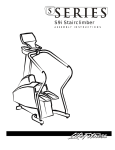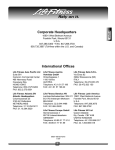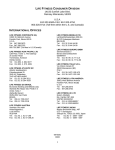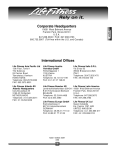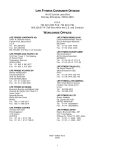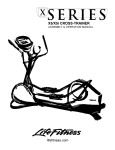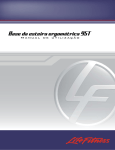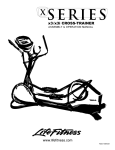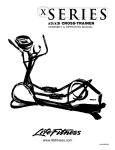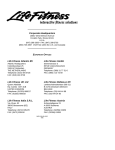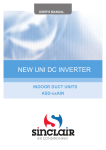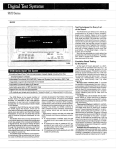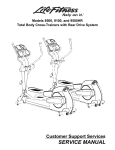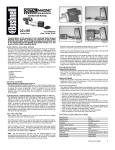Download Owners Manual
Transcript
T M Corporate Headquarters 10601 West Belmont Avenue Franklin Park, Illinois 60131 U.S.A. 847.288.3300 • FAX: 847.288.3703 800.735.3867 (Toll-free within the U.S. and Canada) International Offices Life Fitness Asia Pacific Ltd 12th Floor, Tower 1, The Gateway Tsimshatsui, Kowloon HONG KONG Telephone: 852.2575.6262 FAX: 852.2575.6001 Life Fitness Atlantic BV Atlantic Headquarters Columbusstraat 25 3165 AC Rotterdam NETHERLANDS Telephone: 31.10.294.5011 FAX: 31.10.294.5029 Life Fitness Austria Vertriebs GmbH Hintschiggasse 1 1100 Vienna AUSTRIA Telephone: 43.1.61 57 198 FAX: 43.1.61 57 198.20 Life Fitness Italia S.R.L. Via Elvas 92 39042 Bressanone (BZ) ITALY Telephone: 39.472.835 470 FAX: 39.472.833 150 Life Fitness Benelux NV Lambrechtshoekenlaan 309-311 B-2170 Antwerpen-Merksem BELGIUM Telephone: 32.3.644.4488 FAX: 32.3.644.2480 Life Fitness Latin America 10601 West Belmont Avenue Franklin Park, Illinois 60131 U.S.A. Telephone: 847.288.3675 FAX: 847.288.3762 Life Fitness Europe GmbH Siemensstrasse 3 85716 Unterschleissheim GERMANY Telephone: 49.89.31 77 51.0 FAX: 49.89.31 77 51.99 Life Fitness UK Ltd Queen Adelaide Ely, Cambs CB7 4UB UNITED KINGDOM Telephone: 44.1.353.666 017 FAX: 44.1.353.666 018 M051-00K20-B106 10/98 1 Before using your Lifecycle exercise bike, it is essential that you read this ENTIRE operation manual and ALL instructions. It will help you set up your Lifecycle exercise bike quickly and give instructions on how to use it correctly. FCC Warning - Possible Radio / Television Interference Lifecycle 5500HR Upright and Recumbent Exercise Bikes NOTE: This equipment has been tested and found to comply with the limits for a Class B digital device, pursuant to part 15 of the FCC rules. These limits are designed to provide reasonable protection against harmful interference in a residential installation. This equipment generates, uses and can radiate radio frequency energy, and if not installed and used in accordance with the instructions, may cause harmful interference to radio communications. However, there is no guarantee that the interference will not occur in a particular installation. If this equipment does cause harmful interference to radio or television reception, which can be determined by turning the equipment off and on, the user is encouraged to try to correct the interference by one or more of the following measures: l Reorient or relocate the receiving antenna. l Increase the separation between the equipment and the receiver. l Connect the equipment into an outlet on a circuit different from that to which the receiver is connected. l Consult the dealer or an experienced radio/TV technician for help. Lifecycle 9100 Upright and Recumbent Exercise Bikes NOTE: This equipment has been tested and found to comply with the limits for a Class A digital device, pursuant to part 15 of the FCC rules. These limits are designed to provide reasonable protection against harmful interference when the equipment is operated in a commercial environment. This equipment generates, uses and can radiate radio frequency energy, and if not installed and used in accordance with the instruction manual, may cause harmful interference to radio communications. Operation of this equipment in a residential area is likely to cause harmful interference in which case the user will be required to correct the interference at his own expense. You are cautioned that any changes or modifications to this equipment could void your product warranty! Any service, other than cleaning or user maintenance, must be performed by an authorized service representative. There are no user serviceable parts. 2 TABLE OF CONTENTS Section 1. 1.1 1.2 1.3 2. 2.1 2.2 3. 3.1 3.2 4. 4.1 4.2 4.3 5. 5.1 5.2 5.3 5.4 5.5 Description Page Getting Started . . . . . . . . . . . . . . . . . . . . . . . . . . . . . . . . . . . . . . . . . . . . . . . . 5 Important Safety Instructions . . . . . . . . . . . . . . . . . . . . . . . . . . . . . . . . . . . 5 Set Up . . . . . . . . . . . . . . . . . . . . . . . . . . . . . . . . . . . . . . . . . . . . . . . . . . 6 How to Stabilize the Lifecycle® Exercise Bike How to Adjust the Seat How to Adjust the Footstraps Optional Settings for the Lifecycle Exercise Bike . . . . . . . . . . . . . . . . . . . 9 Maximum Program Time English / Metric Conversion The Display Console . . . . . . . . . . . . . . . . . . . . . . . . . . . . . . . . . . . . . . . . . . . 10 Display Console Overview . . . . . . . . . . . . . . . . . . . . . . . . . . . . . . . . . . . . 10 Display Console Descriptions . . . . . . . . . . . . . . . . . . . . . . . . . . . . . . . . . . 10 Message Center Data Entry Zone Program Profile Window Quick Start Heart Rate Zone Training Exercise® . . . . . . . . . . . . . . . . . . . . . . . . . . . . . . . 13 Why Heart Rate Zone Training Exercise? . . . . . . . . . . . . . . . . . . . . . . . . . 13 Heart Rate Monitoring . . . . . . . . . . . . . . . . . . . . . . . . . . . . . . . . . . . . . . . 14 The Optional Heart Rate Chest Strap The Programs . . . . . . . . . . . . . . . . . . . . . . . . . . . . . . . . . . . . . . . . . . . . . . . . 15 Program Overview . . . . . . . . . . . . . . . . . . . . . . . . . . . . . . . . . . . . . . . . . . 15 The Race Mode Option The Programs Step by Step Program Descriptions . . . . . . . . . . . . . . . . . . . . . . . . . . . . . . . . . . . . . . . . 18 Quick Start Fat Burn Cardio Manual Random Hill Fit Test How to Maximize Workouts on the Lifecycle Exercise Bike . . . . . . . . . . . 26 Selecting the Correct Intensity Level Service and Technical Data . . . . . . . . . . . . . . . . . . . . . . . . . . . . . . . . . . . . . . 27 Preventive Maintenance Tips . . . . . . . . . . . . . . . . . . . . . . . . . . . . . . . . . . 27 How to Solve Basic Operating Problems. . . . . . . . . . . . . . . . . . . . . . . . . . 28 Troubleshooting the Optional Heart Rate Chest Strap . . . . . . . . . . . . . . . . 29 How to Obtain Product Service. . . . . . . . . . . . . . . . . . . . . . . . . . . . . . . . . 30 Lifecycle Exercise Bike Specifications . . . . . . . . . . . . . . . . . . . . . . . . . . . 31 © 1998 Life Fitness, a division of Brunswick Corporation. All rights reserved. Life Fitness, Lifecycle, Lifepulse and Flexdeck are registered trademarks, and Heart Rate Zone Training, Lifespring and “RELY ON IT” are trademarks of Brunswick Corporation. Any use of these trademarks, without the express written consent of Life Fitness is forbidden. 3 This Operation Manual describes the functions of the following products: Lifecycle exercise bikes 5500HR 5500RHR 9100 9100R See “Specifications” page in this manual for product specific features. 4 1 GETTING STARTED 1.1 Important Safety Instructions Before using this product, it is essential that you read this ENTIRE operation manual and ALL instructions. The Lifecycle exercise bike is intended for use solely in the manner described in this manual. Always follow the console instructions for proper operation. Close supervision is necessary when used by or near children, invalids or disabled persons. Never operate a Life Fitness exercise bike if it has been dropped, damaged, or even partially immersed in water. Contact Life Fitness Customer Support Services for assistance. Never insert objects into any opening in your Lifecycle exercise bike. If an object should drop inside, carefully retrieve it. If you cannot reach the item, contact Life Fitness Customer Support Services. Never place liquids of any type directly on the unit, except in an accessory tray. Containers with lids are recommended. Do not use the Lifecycle exercise bike outdoors, near swimming pools or in areas of high humidity. Do not use the Lifecycle exercise bike in areas where aerosol spray products are being used or where oxygen is being administered. Such substances increase the danger of combustion and explosion. Keep all loose clothing, shoelaces, and towels away from the Lifecycle exercise bike pedals. Keep the area around your Lifecycle exercise bike clear of any obstructions, including walls and furniture. Always be careful and exercise caution when mounting or dismounting your Lifecycle exercise bike. Use the handlebar whenever additional stability is required. Wear shoes with rubber or high-traction soles. Do not use shoes with heels,leather soles, cleats or spikes. Do not use the bike in your bare feet. Do not tip the Lifecycle exercise bike on its side during operation. SAVE THESE INSTRUCTIONS FOR FUTURE REFERENCE Life Fitness STRONGLY recommends that if you are undertaking an exercise program please see your physician for a complete medical exam, particularly if you have a family history of high blood pressure or heart disease, are over the age of 45, or if you smoke, have high cholesterol, are obese, or have not exercised regularly in the past year. If, at any time while exercising, you feel faint, dizzy, pain, or shortness of breath, stop immediately. 5 1.2 Set Up How to Stabilize the Lifecyle Exercise Bike Depending on the surface you place your Lifecycle exercise bike on, it may need to be stabilized. After you place the bike where you will primarily use it, check the stability of the bike by attempting to rock it back and forth. If it rocks, it is not stable. To level it, rotate the foot on the stabilizer bar that appears to be higher counter-clockwise (as viewed from above) with your finger until the bike is stable. 6 How to Adjust the Seat A properly adjusted seat is extremely important in any bike-oriented exercise activity and the Lifecycle exercise bike is no exception. If the seat is too close, excessive strain will be placed on the knees and quadriceps muscles; if the seat is too far, the resulting reaching action will irritate the feet, ankles, hips and knees. Sit on the seat and place the balls of your feet on the pedals. An optimum position will allow you to move through the bottom of the stroke without locking your knees or shifting in the seat (your knees should have a slight bend at the point of fullest leg extension). Upright Exercise Bikes: If the seat needs to be adjusted, dismount the bike and pull the springloaded adjusting pin located on the back of the seat post (or pull out the adjusting pin located on the front of the seat post). Slide the seat post up or down as necessary to the proper position and release the pin to complete engagement. Check the seat height again and readjust it if necessary. Recumbent Exercise Bikes: If the seat needs to be adjusted, lift the spring-loaded adjusting handle located on the right, front side of the seat. Slide the seat forward or backward as necessary to the proper position and release the pin to complete engagement. Gently slide the seat forward and backward a small distance to ensure it is locked into place. Check the seat distance again and re-adjust it if necessary. Do not attempt to adjust the seat while you are pedaling the bike. Doing so or failing to insert the seat pin completely may result in an uncomfortable workout or cause injury. 7 How to Adjust the Footstraps The pedals on your Lifecycle exercise bike have footstraps with slits on both the inside and the outside of each strap. To adjust the width of the straps, grasp the outside of the strap and pull down and away from the knob. Once the slotted end is removed, choose a width that will feel the most comfortable while you are riding, reinsert the knob through the slot and pull the strap up. The strap will click when it locks in place. Do not attempt to adjust the pedal footstraps while you are pedaling the bike. Doing so may result in an uncomfortable workout or cause injury. 8 1.3 Optional Settings for the Lifecycle Exercise Bike l Maximum program time The maximum program time option allows the maximum program time to be changed from the default maximum time limit of 60 minutes to anywhere from 1 to 99 minutes. Altering the maximum program time will affect all programs except the Fit Test. To change the Lifecycle exercise bike maximum program time, proceed as follows: 1. Press and hold the key. 2. Begin pedaling (you must reach a minimum of 35 RPM), then press . All LEDs and 14-segment displays will be illuminated. This is called Diagnostic State 1. There are fifteen distinct Diagnostic States and the maximum program time default settings reside in Diagnostic State 6. Each time you press the ENTER key you will advance one diagnostic state. Continue to advance to Diagnostic State 6. 3. When you reach Diagnostic State 6, the current “MAXIMUM DURATION” setting will be displayed. The default maximum program time is 60 minutes. 4. Use key to decrease the “MAXIMUM DURATION” or the “MAXIMUM DURATION”. key to increase the 5. To exit the Diagnostic States, press the CLEAR / PAUSE key repeatedly until you return to the user display. The user display is the initial display console you see when you approach the unit for normal operation. l English / Metric Conversion The factory default is set to english measurement. When you reach Diagnostic State 8 (see above), the Data Entry Window will display ENGLISH to designate english units. To change the default to metric measurement, press the keys and the system will toggle between english and metric units and display METRIC. For more information on the other seven Diagnostic States please refer to the Lifecycle Service Manual available from Life Fitness Customer Support Services. (See How To Obtain Product Service for information on how they can be reached.) 9 2 THE DISPLAY CONSOLE 2.1 Display Console Overview The Lifecycle exercise bike’s display console is easy to use, and it allows you to follow your progress as you ride. The on-board computer lets you tailor your workouts to your individual fitness capabilities and goals while providing a unique means of measuring your fitness improvement from one workout to the next. A B D C 2.2 Display Console Descriptions A Message Center MESSAGE CENTER: Provides all the instructions for programming the Lifecycle exercise bike. In addition it displays elapsed time, level or heart rate, and speed. Total calories burned, calories per hour, distance traveled, MPH (in Race Mode), and Watts or METS (in Watts or METS Mode) are alternately displayed every 5 seconds.The alternating display can be locked on any one value by depressing the Display Lock key. 10 B Data Entry Zone DATA ENTRY ZONE: Allows you to enter information required to set-up a workout or alter your current exercise program. START: The START key activates the display console after you begin pedaling and is then inactive for the remainder of the workout. QUICK PROGRAM: Use this key after pressing the START key and immediately begin a Manual program. THE ARROW KEYS: Use these keys to select all of your workout program parameters, including length of time of your ride, age, weight, gender, target heart rate and effort level. You can also increase or decrease your effort level at any time by pressing either of the keys (or change your target heart rate if you are in the Fat Burn or Cardio programs). ENTER: Use this key to execute input of any information in which you have keyed. It is not necessary to press ENTER when keying in a new effort level. DISPLAY LOCK: This button allows you to freeze the message center display on one set of feedback information - total calories, calories / hour, miles (kilometer), watts, etc. To unlock the display, simply push the Display Lock button again. CLEAR / PAUSE: Use this key during programming to clear an erroneous value. Use this key to put your workout program on hold or restart it. To place your workout on hold, press the key once and continue pedaling (remember, you are powering the machine; if you stop pedaling, all power is lost and the display will go blank). Pedal resistance drops to the minimum when the Lifecycle exercise bike is paused; the stopwatch function is activated and the elapsed time window begins counting up from zero. Use this as a brief rest period if you feel fatigued or to take your heart rate. Press the key twice to end your current program and show the program summary. Press the key a third time to clear the summary information and the Message Center Window prompts you to choose a program. 11 RACE ON / OFF: Lets you toggle in and out of the Race mode at any time in the Hill, Random and Manual programs. The Speed / RPM display will toggle between RPM and MPH / KPH every five seconds. Your MPH will be dependent on your pedal speed and the level chosen. (See the Race Option information.) WATTS / METS: To display Watts, press the Watts / METS key once anytime during a program. To display METS, press Watts / METS key twice. † Factory Setting for Maximum Program Duration is 60 minutes. See Optional Settings for the Lifecycle exercise bike section. C Program Profile Window PROGRAM PROFILE WINDOW: Displays a matrix of lights showing your present position and upcoming terrain. The higher the column of lights the greater the resistance. The left-most column of lights represents your current position. The remaining columns show the upcoming terrain. As your workout progresses, the lights move across the screen from right to left. In the Fat Burn and Cardio programs, a heart shape ( ) will be displayed in the window when you are required to grasp the Lifepulse sensors. A flashing heart will also appear at the conclusion of the Fit Test, again prompting you to grasp the Lifepulse sensors (The heart rate will be read automatically on telemetry equipped models when wearing an optional heart rate chest strap). D QUICK START QUICK START: Tells you how to get right into a workout on your Lifecycle exercise bike. Just start pedaling, press START and then press the 12 key. 3 HEART RATE ZONE TRAINING EXERCISE TM TM 3.1 Why Heart Rate Zone Training Exercise? Research shows that exercising within a specific heart rate range is the optimal way to monitor exercise intensity and achieve maximum results. That is the idea behind the Life Fitness Heart Rate Zone Training exercise program. Zone Training takes the guesswork out of working out by identifying specific ranges, or zones, in which to maintain a heart rate to achieve maximum exercise results according to personal goals. In short, Zone Training all but eliminates under- and over-training by allowing you to target your heart rate to your individual fitness objectives. For instance, if the primary goal is to burn fat, exercise at a level between 60% and 75% of your theoretical maximum heart rate†. To improve cardiovascular condition, you should work out at 75% to 85% of your theoretical maximum heart rate. Life Fitness offers two exclusive programs designed to take full advantage of the benefits of Heart Rate Zone Training: Fat Burn and Cardio. Vary the focus of exercise activities by switching between the Fat Burn and Cardio program at any time during a workout or by entering a new target heart rate with the keypad. Both the Fat Burn and Cardio programs measure heart rate. As you exercise, simply wear an optional heart rate chest strap (on telemetry equipped models) and your heart rate will be transmitted to the on-board computer. The resistance level will automatically adjust to maintain the target heart rate based on your actual heart rate. † (Defined by the American College of Sports Medicine’s “Guidelines for Exercise Testing and Prescription” as 220 minus your age.) 13 3.2 Heart Rate Monitoring The Optional Heart Rate Chest Strap Wet the electrodes to the transmitter (the two grooved surfaces on the underside of the strap) and secure the strap as high under the chest muscles as possible. The strap should be snug, but comfortable enough to allow for normal breathing. The transmitter strap will deliver an optimum heart rate reading when the electrodes are directly in contact with bare skin. However, it will function properly through wet, lightweight clothing. The key to proper operation is for the electrodes to remain wet to conduct the electrical impulses of the heart back to the receiver. If it becomes necessary to remoisten the chest strap transmitter, grasp the center of the strap, pull it away from the chest to expose the two electrodes, then moisten them in this position. 14 4 THE HE PROGRAMS ROGRAMS 4.1 Program Overviews Selecting a workout program on your Life Fitness aerobic trainer is easy. Seven computerized aerobic workouts, including the exclusive Fat Burn, Cardio and Fit Test programs, are preprogrammed on your Lifecycle exercise bike: QUICK START, the fastest way to begin exercising, allows you to immediately start a manual program. FAT BURN is a Heart Rate Zone Training™ program designed to burn an optimum amount of calories from fat by automatically maintaining a target heart rate of 65% of your theoretical maximum heart rate. CARDIO is a Heart Rate Zone Training™ program designed to increase cardiovascular fitness by automatically maintaining a target heart rate of 80% of your theoretical maximum heart rate. MANUAL maintains a constant effort level based on the goals you have selected. RANDOM is a program of varying effort levels which occur randomly with each exercise session, resulting in more than one million workout combinations. HILL is an interval training workout consisting of a warm-up period followed by a plateau of constant effort, progressively more difficult levels of effort (hills) separated by periods of recovery (valleys) and a cool-down period. FIT TEST is a way of measuring the aerobic fitness level of an individual compared to others of the same age and gender. 15 The Lifecycle exercise bike is a “constant work” machine; in the Hill, Random and Manual programs, pedal resistance automatically compensates for changes in RPM. In other words, the slower you pedal, the greater the resistance; conversely, the faster you pedal the less resistance you feel†. The distance you travel will remain the same; pedaling faster will not bring you to the end of a program sooner or burn more calories, assuring you of a consistent workout. If you prefer to be “rewarded” for going faster, try the Race Mode Option. † This is true as long as you pedal faster than 65 RPM. Below 65 RPM, the resistance will drop off to the point where you can continue pedaling at a pace sufficient to maintain power to the console. NOTE: Mileage readings are arbitrary and should not be used to compare workouts in different programs. Total calories burned is the best measure of the amount of work performed in any given workout. The Race Mode Option Formerly a program in and of itself, the Race Mode allows you to vary your pedal resistance to simulate the feel of an actual 20-speed racing bike in the Hill, Random and Manual programs. Turn the Race mode on at any time and the Lifecycle exercise bike’s 20 effort levels are transformed into the “gears” of a high performance road racing bicycle! The pedal resistance will change with the speed at which you pedal, enhancing your workout enjoyment while also allowing you greater control over the program’s intensity (the greater the resistance, the more LEDs will be illuminated). The distance you travel and the calories you burn during your workout will also vary with your pedal speed. 16 The Programs Step by Step 17 4.2 Program Descriptions QUICK START The fastest way to begin exercising, allows you to immediately start a manual program. FAT BURN The Fat Burn and Cardio heart rate management programs work by adjusting the resistance of the Lifecycle exercise bike in response to your heart rate. These two programs use the technology of the Lifepulse digital sensors and/or Polar compatible telemetry (if so equipped) to monitor your heart rate and automatically adjust the work load to maintain your target heart rate. The end result is a perfect workout every time, eliminating both under- and over-training. On the Lifecycle exercise bike, the Fat Burn program will maintain your heart rate at 65% of your theoretical maximum heart rate† or another target heart rate that you enter. Pedal resistance will automatically adjust to maintain the target heart rate. Exercising at 65% of your theoretical maximum heart rate maximizes the aerobic benefits of exercise by accessing the body’s fat stores for fuel and by allowing you to exercise longer. CARDIO The Cardio program is virtually identical to the Fat Burn program. The only difference is that your target heart rate is calculated at 80% of your theoretical maximum to accentuate cardiovascular improvement by placing a heavier work load on the heart muscle. If you wish to vary the focus of your exercise activities, once the warm-up is complete, you may switch back and forth between the Fat Burn and Cardio programs at any time during a workout simply by pressing the ENTER key, creating the ultimate interval training program! Remember, you may change your target heart rate at any time after the warm-up period by simply pressing the keys or toggling fat burn and cardio target heart rates using the ENTER key. The Life Fitness Heart Rate Zone Training programs begin with a three minute warm-up period designed to safely get you closer to your target heart rate from a resting start. It should take two to three minutes for your heart rate to reach your target. NOTE: If your heart rate is above the chosen target during the warm-up period, the warm-up period will immediately end and the Lifecycle exercise bike will begin automatically varying its resistance to maintain your target heart rate. †Defined by the American College of Sports Medicine’s “Guidelines for Exercise Testing and Prescription” as 220 minus your age. 18 Manual and Random Programs MANUAL PROGRAM The Manual program provides steady-pace exercise equal to that of the highest hill encountered on the Hill program at the same level of effort. Because of the greater resistance levels of this program, it is recommended that you set the Manual program lower than the level of effort that you would normally select on the Hill program. You can design your own interval training program using the Manual program by varying the level of effort during the course of your workout. To do so, select a high level of resistance until you reach the upper end of your target heart rate zone, then ride at a lower effort level until your heart rate drops to the bottom of your target zone. Then increase the level of effort again until you are back to the upper portion of your target zone. By repeating this process, you will actually be creating your own hills and valleys. RANDOM PROGRAM The computer randomly selects hill and valley terrain which varies with each and every workout, resulting in more than one million combinations. Because resistance levels are greater in this program than in the Hill program, it is recommended that the Random program be set one or two levels lower than the level of intensity you would normally select on the Hill program. 19 Hill Program HILL The Lifecycle exercise bike’s patented Hill program offers the ideal configuration for interval training: periods of intense aerobic activity separated by regular intervals of lower-intensity exercise. Interval training programs have been scientifically demonstrated to yield greater cardiorespiratory improvement than steady-pace training. Not only does the Hill program offer the challenge of alternating periods of high and low intensity, but the levels of intensity become progressively more difficult during the course of the program. Because you have the option of working out in a Hill program for anywhere from 1 to 99 minutes, and because the Hill program is composed of four distinct phases, the program must be structured differently to accommodate the entire array of program durations. Longer workouts add more hills. Each Hill program session comprises the following phases: (1) Warm-up, (2) Plateau, (3) Interval Training, and (4) Cool-down. l Warm-up: Gradually brings your heart rate into the lower portion of your target heart rate zone, increasing respiration and blood flow to working muscles. l Plateau: Brings your heart rate into your target zone. Check your heart rate at the end of the plateau period to ensure that you have entered your target heart rate zone. l Interval Training: A series of hills and valleys. During this portion of your workout, you will be confronted with sets of four successively steeper hills, each separated from the next by a valley, or recovery period. Check your heart rate at the end of the interval training period to ensure that you have stayed within your target zone. l Cool-down: The cool-down allows your body to begin removing accumulated byproducts of exercise, such as lactic acid, which build up in muscles during your workout and contribute to muscle soreness. 20 The Hill diagram below shows the effort level and recovery periods encountered during a Hill workout. Effort and recovery periods are simulated on the display console by columns of lights in the Program Profile Window. The columns move from right to left during the workout. The higher the column, the higher the incline; consequently, you must increase the effort. Heart Rate Check Points For Fat Burning: 4 4 First Heart Rate Check Point — Your heart rate should be between 60% and 70% of the theoretical maximum heart rate for your age category. Second Heart Rate Check Point — Your heart rate should be between 70% and 75% of the theoretical maximum heart rate for your age category. For Cardio: 4 4 First Heart Rate Check Point — Your heart rate should be between 75% and 80% of the theoretical maximum for your age category. Second Heart Rate Check Point — Your heart rate should be between 80% and 85% of the theoretical maximum for your age category. Be sure to check your heart rate near the end of the plateau and interval training periods. If you are not wearing an optional heart rate chest strap, see Hill diagram above. You should always take your heart rate at the time indicated to make sure you are staying within your target heart rate zone. 21 FIT TEST The Lifecycle exercise bike Fit Test program is another exclusive feature of this versatile exercise bike. Your Fit Test score is also an approximate measure of your VO2 max; think of it as your relative fitness score. Use the Fit Test to monitor improvement in your endurance every four to six weeks. l l l l After selecting the Fit Test program using the keys, the message center will ask for your age (ENTER AGE). Use the keys to input your age and press ENTER. After entering your age, you will be asked for your weight (SELECT WEIGHT). Use the keys to input your weight and press ENTER. After entering your weight, the message center will prompt you to select your gender (SELECT GENDER). Press the keys to do so, for male or for female and then press ENTER. After selecting a gender the message center will prompt you to select a workout level (SELECT LEVEL). Consult the Activity Levels chart on the following page for the effort level you should input based on your age, gender and activity level. Use the keys to enter the corresponding level. After having completed the five-minute Fit Test, your heart rate will be automatically entered from your optional heart rate chest strap by the on-board computer (to enter heart rate manually, use the time prompt to take your pulse and enter it with the keys). The Fit Test score will be displayed, which you can use to find your ranking in the Fit Test scoring tables located in this section. 22 RECOMMENDED FIT TEST LEVELS AGE WEIGHT (KG) INACTIVE ACTIVE VERY ACTIVE <30 <130 131-169 170-210 >210 <59 59.5-76.8 72.3-95.5 >95.5 2 4 5 7 4 5 7 9 5 7 9 10 30-39 <130 131-169 170-210 >210 <59 59.5-76.8 72.3-95.5 >95.5 1 2 4 5 2 4 5 7 4 5 7 9 40-49 <130 131-169 170-210 >210 <59 59.5-76.8 72.3-95.5 >95.5 1 2 2 4 1 2 4 5 2 4 5 7 50+ <130 131-169 170-210 >210 <59 59.5-76.8 72.3-95.5 >95.5 1 1 2 2 1 2 2 4 1 2 4 5 NOTE: If your weight varies from these values substantially, you may wish to increase or decrease the indicated levels accordingly. If your heart rate is below 65% of your theoretical maximum heart rate at the conclusion of the Fit Test, retake the test at a higher level. The Fit Test is an estimate of your VO2 max, which is a measurement of how well the heart supplies oxygenated blood to the exercising muscles and how efficiently those muscles receive oxygen from the blood. This measurement is generally regarded by physicians and exercise physiologists as the standard for aerobic capacity. 23 Fit Test Tips The computer will not accept: l l l l heart rates less than 90 or greater than 199 beats per minute body weights less than 74 pounds (34 kg) or greater than 350 pounds (159 kg) ages below 10 or over 99 years data input that exceeds human potential If you make an error when entering any Fit Test data, you can correct it by pressing CLEAR / PAUSE, inputting the correct information, and pressing ENTER. It is important to take the Fit Test under similar circumstances each time. The heart rate is dependent on many factors, including: l l l l l amount of sleep the previous night (at least seven hours is recommended) time of day time since last meal (two to four hours after the last meal is recommended) time since last drinking a liquid containing caffeine or alcohol, or smoking a cigarette (at least four hours is recommended) time since having last exercised (at least six hours is recommended) For the most accurate Fit Test results, you should perform the Fit Test on three consecutive days and average the three scores. NOTE: To receive a proper Fit Test score, you must work within your training heart rate zone, which is 60% to 85% of your theoretical maximum heart rate. 24 RELATIVE FITNESS CLASSIFICATION FOR MEN AGE Rating Elite Excellent Good Above Average Average Below Average Poor Very Poor 20 - 29 55+ 50 - 54 45 - 49 40 - 44 36 - 39 31 - 35 26 - 30 <26 30 - 39 52+ 47 - 51 42 - 46 37 - 41 33 - 36 28 - 32 23 - 27 <23 40 - 49 50+ 45 - 49 40 - 44 35 - 39 31 - 34 26 - 30 20 - 25 <20 50 - 59 48+ 43 - 47 38 - 42 33 - 37 29 - 32 24 - 28 18 - 23 <18 60+ 45+ 40 - 44 35 - 39 30 - 34 26 - 29 21 - 25 16 - 20 <16 RELATIVE FITNESS CLASSIFICATION FOR WOMEN AGE Rating Elite Excellent Good Above Average Average Below Average Poor Very Poor 20 - 29 49+ 44 - 48 39 - 43 34 - 38 30 - 33 25 - 29 20 - 24 <20 30 - 39 46+ 41 - 45 36 - 40 31 - 35 27 - 30 22 - 26 17 - 21 <17 40 - 49 44+ 39 - 43 34 - 38 29 - 33 25 - 28 20 - 24 15 - 19 <15 25 50 - 59 42+ 37 - 41 32 - 36 27 - 31 23 - 26 18 - 22 13 - 17 <13 60+ 40+ 35 - 39 30 - 34 25 - 29 21 - 24 16 - 20 11 - 15 <11 4.3 How to Maximize Workouts on the Lifecycle Exercise Bike In the Lifecycle exercise bike’s Manual, Random and Hill workout programs, you can change the level of intensity at any time by simply pressing a new number between 1 and 20 by pressing the keys. In addition, should you decide to work out in one program after starting another, simply push CLEAR three times to clear the first program and then select the new program. Selecting the Correct Intensity Level The Lifecycle exercise bike offers 20 levels of intensity, or difficulty, from which to choose. Level 1 is the easiest and level 20 is the most challenging. Select a low effort level until you become accustomed to the Lifecycle exercise bike, then increase the intensity as your condition improves. The Random and Manual programs are proportionately more difficult than the Hill program. Because of this, you should be careful to select an effort level in the Random program that is one to two levels lower than you would normally select in the Hill program. Conversely, if you choose the Manual program, you should select an intensity level that is at least three levels lower than the level you would normally work out at in the Hill program. The following table will allow you to compare the relative intensities of the four Lifecycle exercise bike computerized fitness programs. HILL RANDOM MANUAL OR FIT TEST 1 1 1 3 3 2 7 5-7 3 10 8 5 13 12 - 13 7 17 15 8 17 - 18 10 20 12 18 - 20 13 15 17 18 20 26 5 SERVICE AND TECHNICAL DATA 5.1 Preventive Maintenance Tips Your Lifecycle exercise bike is backed by the engineering excellence of Life Fitness and is one of the most reliable, rugged and trouble-free pieces of exercise equipment on the market today. Commercial Life Fitness exercise bikes are among the most popular of aerobic trainers, regularly standing up to marathon use — 18 hours a day, 7 days a week — in health clubs, colleges and military facilities the world over. Here are some preventive maintenance tips that will keep your Lifecycle exercise bike operating at peak performance: l Locate your Lifecycle exercise bike in a cool, dry place. l Clean the seat surface regularly. l l l Clean the seat extrusion with a soft cloth and a non-abrasive liquid cleanser and check the seat adjustment pin insertion monthly. Keep the display console free of fingerprints and salt build-up caused by sweat. Use a 100% cotton cloth lightly moistened with water and a mild liquid detergent (other fabrics or paper towels may scratch the surface). Long fingernails may scratch the surface of the console. Use the pad of your fingertip to press the console buttons. NOTE: NEVER remove the stabilizer bar. When cleaning the exterior of the unit, a non-abrasive cleanser and soft cotton cloth are strongly recommended. At no time should cleanser be applied directly to any part of the equipment; use non-abrasive cleanser on a soft cloth and then wipe the unit. DO NOT step on any portion of the housing when getting on or off the bike; doing so may crack the housing. The correct way to get on (mount) the recumbent Lifecycle exercise bike is to step over and straddle the housing, then lower yourself onto the seat. Reverse the procedure to get off (dismount). 27 5.2 How to Solve Basic Operating Problems SYMPTOM PROBABLE CAUSE CORRECTIVE ACTION 9-volt battery missing Install 9-volt alkaline battery 9-volt battery too low Replace 9-volt alkaline battery Harness not connected Disconnect and reconnect harness Difficult to pedal 10 to 15 hour break-in period not complete Ride the bike for 10 to 15 hours Bike shuts off during ride Pedaling too slow Pedal at 35 rpm minimum Not entering desired workout duration Check that desired workout duration appears in display window prior to pressing ENTER Wire harness connector loose Carefully remove console and disconnect then reconnect the 10-pin connector No Power Display flickers or fades in and out 28 5.3 Troubleshooting The Optional Heart Rate Chest Strap The optional heat rate chest strap is required when using a recumbent Lifecycle bike which is equipped with Polar compatible telemetry heart rate monitoring technology. The heart rate reading is erratic or absent entirely: l Repeat the electrode wetting procedure (see How to Use the Optional Heart Rate Chest Strap). The electrodes must be wet to pick up and transmit accurate heart rate readings. l Make sure the electrodes are flat against the skin. l Wash the belt transmitter regularly with mild soap and water. l l Make sure the chest strap transmitter is within three feet (one meter) of the heart rate receiver. The estimated battery life of the chest strap transmitter is 2500 hours of use. If the chest strap transmitter battery is depleted, contact Life Fitness Customer Support Services for instructions on how to have your chest strap replaced. (See “How to Obtain Product Service” for locations.) The heart rate reading is erratic or extremely high (above 200): l When exercising with the heart rate chest strap, it may come within range of electromagnetic signals strong enough to cause abnormally elevated heart rate readings. Possible sources of such signals include television sets and / or antennas, computers, cars, high voltage power lines and motor driven exercise equipment. Another heart rate transmitter within three feet (one meter) may also cause abnormal heart rate readings. NOTE: There is a very small – less than one percent – portion of the general population whose heart rates can not be detected by heart rate monitors, including Electrocardiograph. This phenomenon is called biopotential and is extremely rare. 29 5.4 How To Obtain Product Service Step 1 Verify the symptom and review the operating instructions and How To Solve Basic Operating Problems within this manual. The problem may be unfamiliarity with the recumbent Lifecycle exercise bike's features and programs. Step 2 Locate and document the serial number of the unit, which is located on the underside of the bike, just behind the front stabilizer bar. Step 3 Contact the nearest Life Fitness Customer Support Services group: Toll-free within the U.S.and Canada Telephone: 800.351.3737 or 847.451.0036 FAX: 847.288.3702 For Product Service Internationally: Life Fitness Europe GmbH Telephone: 49.89.317751.66 FAX: 49.89.317751.38 Life Fitness (UK) Ltd Telephone: 44.1.353.665507 FAX: 44.1.353.666018 Life Fitness Benelux NV Telephone: 32.3.644.4488 FAX: 32.3.644.2480 Life Fitness Italia S.R.L. Telephone: 39.472.835470 FAX: 39.472.833150 Life Fitness Austria Vertriebs GmbH Telephone: 43.1.61.57198 FAX: 43.1.61.57198.20 Life Fitness Asia Pacific Ltd Telephone: 852.2575.6262 FAX: 852.2575.6001 Life Fitness Latin America Telephone: 847.451.0036 FAX: 847.288.3702 Please have the serial number of the Lifecycle exercise bike and the problem / symptom ready for the Customer Support Services Specialist who will be assisting you. This information is necessary for us to help solve any problems you may be having. 30 5.5 Lifecycle Exercise Bike Specifications Power requirements None Programs Quick Start, Fat Burn, Cardio, Manual, Random, Hill, Fit Test Console displays Elapsed time, pedal RPM and MPH or KPH, calories per hour (Watts or METS optional), total calories burned, distance traveled (miles or kilometers), resistance level, heart rate (when wearing an optional telemetry heart rate monitoring chest strap on models equipped with telemetry monitoring systems) Heart Rate monitor system LC5500HR, LC5500RHR Polar compatible telemetry heart rate monitoring system (with Heart Rate chest strap) LC9100, LC9100R Polar compatible telemetry heart rate monitoring system (optional Heart Rate chest strap required) Color LC5500HR, LC5500R Light granite LC9100, LC9100R Dark gray Maximum user weight LC5500HR, LC5500R 250 lbs / 114 kg LC9100, LC9100R 350 lbs / 159 kg LC5500HR, LC9100 46 in. / 116.8 cm 23 in. / 58.4 cm 55 in. / 139.7 cm 87 lbs. / 39.4 kg LC5500R, LC9100R 56 in. / 142.2 cm 25 in. / 63 cm 48 in. / 121.9 cm 121 lbs. / 54.8 kg LC5500HR, LC9100 46 in. / 116.8 cm 23 in. / 58.4cm 37 in. / 94 cm 105 lbs. / 47.6 kg LC5500R, LC9100R 55 in. / 139.7 cm 27 in. / 68.6 cm 44 in. / 111.8 cm 159 lbs. / 72 kg ASSEMBLED DIMENSIONS: Length Width Height Weight SHIPPING DIMENSIONS: Length Width Height Weight 31 32 33 34




































